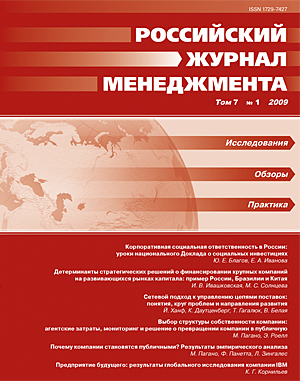Сетевой подход к управлению цепями поставок: понятия, круг проблем и направления развития
Аннотация
Исследования в рамках различных теорий экономической организации показывают, что для управления снабженческими взаимоотношениями необходимо согласование не только действий, но и интересов участников взаимоотношений. В результате цепи поставок, охватывающие эти взаимоотношения, все чаще рассматриваются в качестве сетей поставок. В то же время исследователи сетевых форм межфирменной кооперации утверждают, что межфирменные сети следует анализировать, по меньшей мере, на трех уровнях: уровне фирмы, уровне двухсторонних отношений и сетевом уровне. Однако в сетях поставок согласование действий и согласование интересов редко рассматриваются на всех указанных уровнях одновременно. Таким образом, существует риск упущения из виду важных управленческих проблем, и необходима разработка единого сетевого подхода к управлению цепями поставок. В данной статье мы предлагаем такой подход, основывая нашу аргументацию на результатах обзора литературы по сетевым формам межфирменной кооперации и управлению цепями поставок.
Ключевые слова:
сетевой подход, управление цепями поставок, согласование интересов, согласование действий
Скачивания
Библиографические ссылки
REFERENCES IN LATIN ALPHABET
Загрузки
Опубликован
Как цитировать
Выпуск
Раздел
Лицензия
Статьи журнала «Российский журнал менеджмента» находятся в открытом доступе и распространяются в соответствии с условиями Лицензионного Договора с Санкт-Петербургским государственным университетом, который бесплатно предоставляет авторам неограниченное распространение и самостоятельное архивирование.





